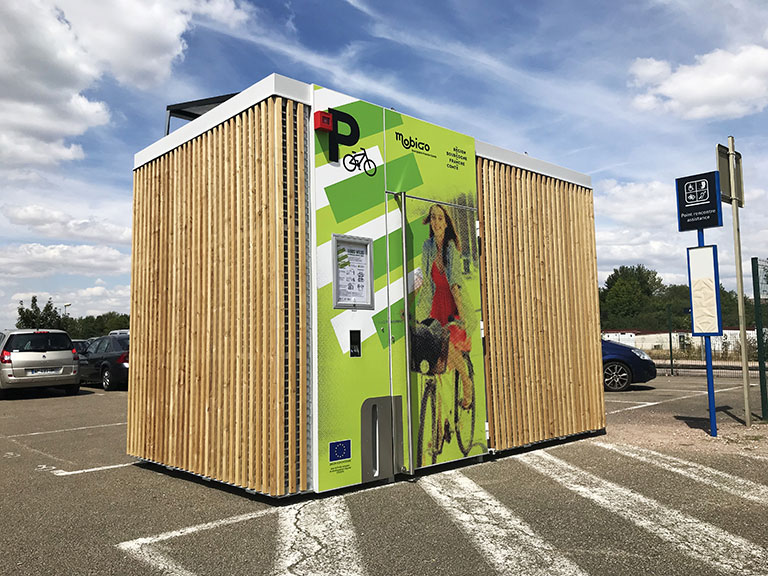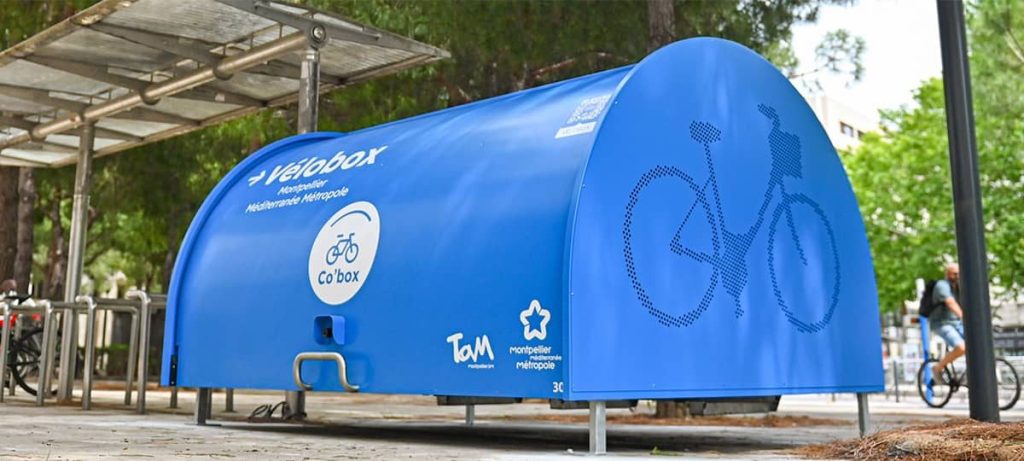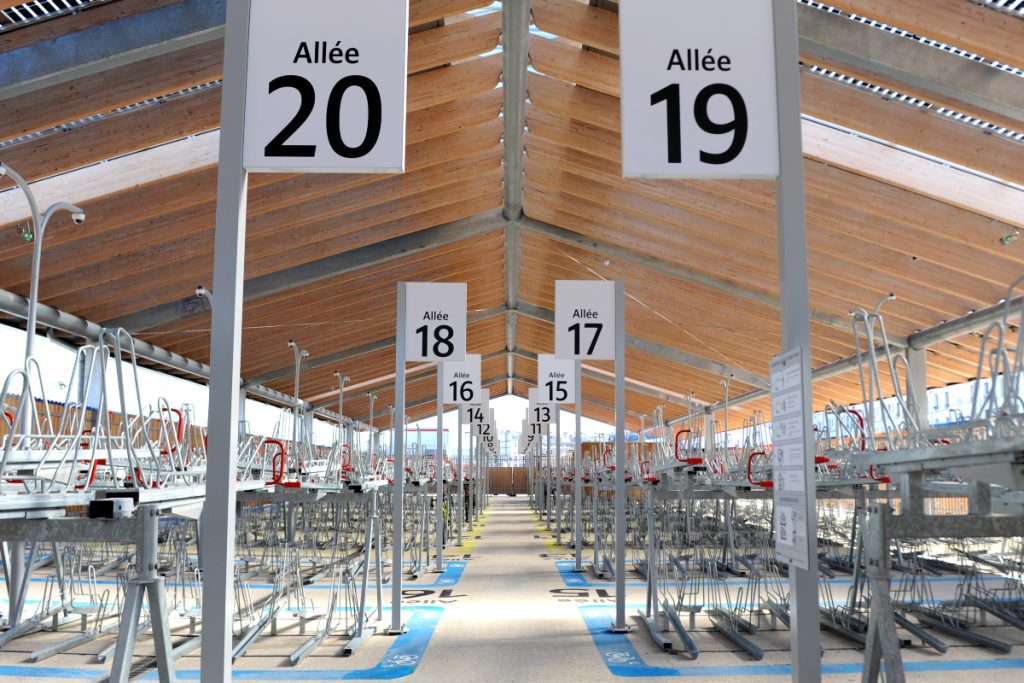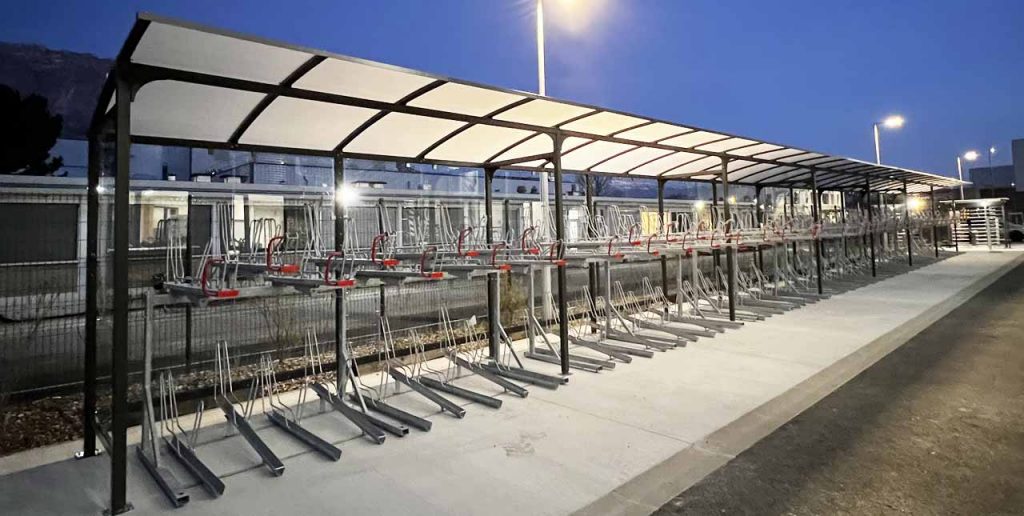
Bike shelters have become essential in modern urban environments. They offer protection against the weather and provide enhanced security against theft and vandalism. In public areas, bike shelters help encourage the use of this eco-friendly and cost-effective mode of transport. Altinnova presents its complete guide to professional bike shelters, including practical advice for selecting and maintaining your equipment.

Open or Enclosed bike shelters?
Depending on the desired level of accessibility, your bike shelter can be open or enclosed. Enclosed shelters are ideal for long-term parking or for securing high-value bikes (such as e-bikes), as they provide maximum protection against weather and theft. They can be equipped with locking systems such as padlocks, codes, key cards, keys, or even smartphone apps. This makes them an ideal investment for train stations, residential buildings, or businesses wishing to offer a secure bike storage facility and promote active mobility.
The open shelter can be compared to a shade shelter, a roof or a covered area. It is accessible to all cyclists for short-term parking, as there is no door and therefore no subscription system, for example. Open cycle shelters are less secure but offer good protection from the rain and sun. They are more economical and easier to install. A practical solution for many public spaces, such as schools, shop car parks or rest areas along greenways.
Individual Bike Lockers or Collective Bike Shelters?
Altinnova offers a full range of individual bike lockers and collective bike shelters depending on your specific needs. Individual lockers are designed to hold a single bicycle, offering maximum security for all its accessories (bags, batteries, lights, bells, counters), and even for cyclists’ personal items like helmets, gloves, or jackets. Although they require more space and offer fewer parking spots, they provide unmatched security thanks to their independent compartments. Bike lockers are commonly installed in train stations, metro stops, university campuses, and other public areas where a high level of security is needed.

A collective bicycle shelter is a covered, shared space where several bicycles can be parked together, either open or closed. Access is free or semi-controlled, but always without an individual locking system. Collective shelters are commonly found near schools, offices, parks and shopping centres, where the main objective is to provide a convenient and protected parking space for several users.
What is a Secure Bike Shelter?
A secure bike shelter offers enhanced protection against theft and vandalism. In addition to shielding bikes from the elements, access is restricted by key, code, access card, or online reservation. It can be used either as a self-service facility (each user locks the door with their own lock) or by subscription (registered users gain access to the closed shelter).
To ensure optimal security, installation must be strategically located. With over 20 years of experience in bike parking solutions, Altinnova supports you through every step, helping you choose the right:
In conclusion, the open bike shelter offers the least protection, and will be used mainly for short-term parking and protection against bad weather. Closed collective shelters offer greater protection against theft and vandalism for long-term parking. Lastly, individual cycle lockers meet the protection criteria for two-wheelers and their components.
Why offer bicycle shelters?
Installing a bike shelter in the city
The promotion of soft mobility is the hobbyhorse of many regions and conurbations. Clearing up urban pollution by reducing the number of motor vehicles means creating spaces for environmentally-friendly transport. Bicycle shelters provide comfort and accessibility solutions for cyclists, particularly during their daily commute.
Installing a bicycle shelter in the workplace
Providing bicycle shelters in the workplace is one way of promoting a healthy lifestyle among employees. This can improve employee satisfaction and loyalty, while contributing to a positive brand image in terms of social and environmental responsibility.
Installing a bike shelter at the station
Railway stations are key points for commuters. Secure bike shelters make it easy for travelers to combine bicycles and public transport. This facilitates multimodal travel and helps reduce car use.
Installing a bike shelter in a condominium
A secure bicycle shelter can help improve the quality of life in a condominium. It’s a practical, safe solution that means residents don’t have to park their bikes on the street or in their apartments. An added value for the common spaces of a building or housing estate.
NB: Bicycle parking is governed by law and may be a legal obligation for private operators, particularly in the case of new buildings or renovations. It is essential to find out about the regulatory requirements to ensure that your facilities are compliant.
How do I choose a bike shelter?
Now that you know the main differences between enclosure models and why you should buy one, here’s some advice on how to make a success of your landscaping project.
Defining your cycling development project
Budget your bike shelter project
To carry out your bike shelter project, you need to budget for the costs of installation, maintenance and possible security options and bike service stations. Funding programs are available for the creation of bicycle parking facilities.
Maintain and manage your bicycle shelters
Bicycle shelters must be designed as sustainable projects. The idea being to promote a more responsible mode of travel, it would be a shame to offer shelters with a short lifespan. Altinnova offers you its advice on management and maintenance to ensure the longevity of these facilities.
Preventive maintenance and upkeep of bicycle shelters
Regular maintenance extends the life of your shelters. Altinnova supports you from A to Z in the realization of your project, but also in its upkeep, thanks to preventive and curative maintenance services for the equipment installed. We take care to ensure that the equipment functions properly, preventing any malfunctions.
Preventing damage to bicycle shelters
To prevent vandalism and damage, we choose resistant metal materials. Our uncluttered, neutral design allows our bike furniture to blend in with any décor, avoiding the temptation to vandalize. Finally, our shelters are designed to effectively conceal the contents of each bike locker to prevent theft.
Taking care of cyclists
To offer a bicycle parking service that works, it’s imperative to install quality parking facilities. However, it’s also important to think about users and make their lives easier. For example, by integrating clearly identifiable signage around the bike shelter, displaying details of the service offered on the stall and installing effective staking to make access to the locker obvious if necessary. Taking care of cyclists also means offering a successful customer experience via an up-to-the-minute application, as well as real customer service to support subscribers.

Choosing the right bike shelter means addressing a clear set of requirements and budgeting accordingly. Altinnova offers a comprehensive range of high-quality products, along with a team of passionate experts to guide you throughout your project—from concept to long-term management.
Get in touch with our team today and start building a greener future, two wheels at a time!